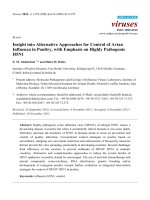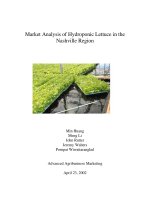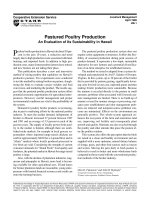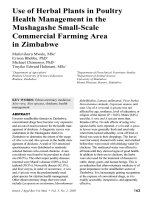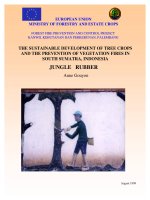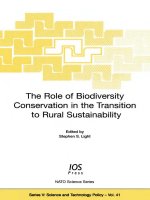Standardization of propagation techniques in Jamun
Bạn đang xem bản rút gọn của tài liệu. Xem và tải ngay bản đầy đủ của tài liệu tại đây (252.99 KB, 9 trang )
Int.J.Curr.Microbiol.App.Sci (2018) 7(10): 2143-2151
International Journal of Current Microbiology and Applied Sciences
ISSN: 2319-7706 Volume 7 Number 10 (2018)
Journal homepage:
Original Research Article
/>
Standardization of Propagation Techniques in Jamun
Harvinder Kaur and Amarjeet Kaur*
Department of Horticulture (Agriculture), Khalsa College, Guru Nanak Dev University,
Amritsar – 143001, India
*Corresponding author
ABSTRACT
Keywords
Jamun, T-budding, Cleft
grafting, Propagation,
Survival, Patch budding,
Sprouting
Article Info
Accepted:
15 September 2018
Available Online:
10 October 2018
The present study entitled Standardization of propagation techniques in jamun was carried
out at the nursery of Department of Horticulture, Khalsa College, Amritsar during 20172018. It comprises of ten planting times commencing from May to February and three
methods of propagation i.e. T- budding, patch budding and cleft grafting. The results of the
study indicated that out of the propagation methods tried patch budding proved to be the
best in terms of minimum days to sprouting (21.7), maximum success percentage
(94.54%), maximum survival percentage (90.11), maximum average leaf area (17.07 cm 2),
maximum leaf fresh weight (0.19g) and maximum leaf dry weight (14.89mg). Among
planting time 1-15th August proved to be the most suitable in improving the root, shoot and
leaf parameters. Maximum number of leaves/plant (8.56), stem thickness (0.75 cm) was
recorded in cleft grafting propagation technique in jamun.
Introduction
Jamun (Syzygium cumini Skeels.) is known to
be an indigenious and important minor crop in
India. It belongs to family Myrtaceae and is
also known as Syzygium jambolanum and
Eugenia cumini. Other names are jambul,
black plum, java plum, etc. (Baloda et al.,
2016). Jamun is native to India and its
bordering countries like Burma, Ceylon,
Nepal, Pakistan, Bangladesh, Sri Lanka,
Indonesia and Andaman islands. India ranks
second next to Brazil in area and production in
world (Bodkhe and Rajput 2010). In India
maximum number of jamun trees is found
scattered throughout the tropical and
subtropical region. It is a large evergreen tree
attaining a height of 25-30 m and a stem girth
of 3-4 m. It is a beautifully shaped tree and is
grown for its delicious fruits, shade and
windbreak on the bunds of roadside avenues
(Shinde et al., 2011). The fruit has sub-acid
spicy flavour. Presence of various flavonoids,
essential oils and molecules such as gallic
acid, oxalic acid, malic acid, betulic acid,
phytosterols, resins and tannins contribute to
its jams, jellies, squashes, vinegar, juices,
beverages, pickles and wine made from the
jamun fruits. Jamun squash is a refreshing
drink for quenching the thirst in summer
season. It is also dried with salt and preserved
as a digestive powder or churan. A large
quantity of food syrup is much useful for
curing diarrhoea. The berry fruit consumption
also provides benefits during chemotherapy
and radiation (Kannan and Puraikalan, 2013).
2143
Int.J.Curr.Microbiol.App.Sci (2018) 7(10): 2143-2151
The volatile oil from the jamun seeds can be
extracted and used as an effective medicine
against heart and liver trouble (Vijayanand et
al., 2001). As this crop has gained importance
due to its medicinal and nutritive value the
orchardists are demanding an early bearing
and dwarf tree with high yield potential. Seed
propagation is not advisable as it results in late
bearing. Asexual techniques are the easy ways
to preserve the certain characters of variety.
The main vegetative methods of propagation
like patch budding, T- budding and soft wood
grafting are performed in jamun (Shinde et al.,
2011). The time of budding depends mainly
on temperature, humidity and availability of
budding material (Nath et al., 2000) found that
the percent success of budding depends on the
budding time.
There is great necessity of an appropriate
propagation method. These methods need to
be tested at different time period with their
suitable rootstock thickness. Due to its
medicinal nutritive value its demand is
increasing day by day that will require
selected plants of superior quality with
desirable potential (which is only possible
when desirable mother trees are used for the
propagation). The research work on vegetative
propagation of the crop is rather scanty.
Therefore, the present investigation was made
to assess the effect of different dates and
method of budding and grafting on the success
and growth of jamun.
were defoliated immediately after collection
from the trees. The scion shoots were
collected from mother trees in the early
morning hours (7 to 9 am) on the day of
budding and grafting. Scions were wrapped in
moist cloth after the separation from mother
trees and carried in polythene cover to the site
of experimental site. Healthy one year old
shoots of the pencil thickness were selected.
Scion shoots were dipped in 0.1 per cent
Bavistin solution to make the scion material
free from pest and diseases. Budding and
grafting was performed on the day of
separation of scion from mother tree.
Two methods of budding i.e. T-budding, patch
budding and one method of grafting i.e. cleft
grafting were performed on first fifteen days
of the each month from May to February 2017
forming ten treatments and two sub treatments
comprising of three methods. Plant protection
measures were employed to prevent the
disease and pest incidence. Grafts and
buddlings were watered daily with required
quantity of water. Side shoots arising from any
portion of rootstock were removed regularly.
Experiment was performed with Factorial
Randomised block design. The data regarding
the number of days taken to sprouting,
survival percentage, root, shoot and leaf
parameters were observed.
Results and Discussion
Percent success (%)
Materials and Methods
The present studies on “Standardization of
propagation techniques in jamun” were
conducted in the year 2017-2018 at the
nursery of Department of Horticulture, Khalsa
College, Amritsar. Desi rootstock of uniform
size and vigour having 0.5 to 1 cm in diameter
were selected for budding and grafting. Rajamun tree were selected for scion material
from Khalsa College, Amritsar. The bud sticks
It is evident from the data that the highest per
cent success (86.49%) was recorded during 115th August and among various methods of
propagation the highest (40.82%) per cent
success was recorded in patch budding while
the minimum per cent success was (0.73%)
during1-15th December and (35.10%) with
cleft grafting. Interaction of time and methods
of propagation also had a significant effect on
per cent success of jamun. After 90 days from
2144
Int.J.Curr.Microbiol.App.Sci (2018) 7(10): 2143-2151
propagation, the highest per cent success
(94.54%) was recorded in patch budding
during 1-15th August while the minimum
(2.19%) was during 1-15th December with
patch budding. It is also clear from the data
that all the propagation methods tried proved
unsuccessful in the months of January and
February. Superiority of patch budding over
other methods with respect to per cent success
might be due to the larger bark and cambium
tissues in patch budding operation. Highest
success in patch budding is in accordance with
the findings of Manohran et al., (2000) in
jamun and Kumar et al., (2007) in guava.
This also might be due to the most favourable
temperature and humidity for success. The
minimum or below average percentage of
successful bud-take was recorded in the
budding performed during May, December,
January and February. The low bud take
percentage during this period might be due to
immature bud wood and low sap flow. The
present results are also in line with the
research findings of Rani et al., (2015) in
guava. Ram and Akhilesh (2005) and Singh
and Singh (2006) also reported the same in
jamun (Table 1).
Number of days taken for bud sprouting
According to the data among different time
and methods of propagation, minimum (21.87)
number of days taken to sprouting were
recorded in patch budding and the best time
for the bud sprouting was 1-15th August.
Number of days taken to sprouting of jamun
was also influenced by the interaction of time
and methods of propagation in jamun where
minimum (21.7) number of days to sprout was
observed in patch budding during 1-15th
August. The interaction of time and methods
of propagation showed a significant effect on
average days taken for bud sprouting. The
maximum days (42.97) were recorded in cleft
grafting during 1-15th November while the
minimum (21.7) were during 1-15th August
with patch budding. The reason for early
sprouting irrespective of planting time on
propagating methods might be attributed to its
better adaptability to meterological conditions
existing at the time of propagation on better
physiological conditions and more active
buds. The emerging sprout is controlled by the
apical dominance and rate of supply of
substrates along with presence of appropriate
environment in terms of temperature, moisture
and oxygen the cell division takes place in the
presence of phytohormones and energy
liberated by hydrolysis of carbohydrates and
polysaccharides occur through enzymatic
pathways is utilized. Many other changes
during the sprouting such as hydrolysis of
starch involve several types of amylase.
Findings are in conformity with the results
obtained by Panday and Singh (2001) in
mango, Giri and Lenka (2007) in jamun, ElZaher (2008) and Selvi et al., (2008) in
jackfruit, Kudmulwar et al., (2008) in custard
apple, Shinde et al., (2011) and Angadi and
Karadi (2012) in jamun. Mahore et al., (2014)
also reported the same in jamun (Table 2).
Survival percentage (%)
Maximum survival percentage (39.50%) was
observed in patch budding during 1-15th
August. Survival percentage was also
influenced by the interaction of time and
methods of propagation in jamun where
maximum survival percentage (90.11%) was
observed in patch budding during 1-15th
August. The results of the present study is also
in agreement with the findings of Baloda et
al., (2016). As regards to the interaction of
time and methods of propagation it exerted a
significant effect on survival percentage of
jamun. After 90 days from propagation, the
highest survival percentage (90.11%) was
recorded in patch budding during 1-15th
August while the minimum (8.07%) was
during 1-15th December with patch budding
(Table 3).
2145
Int.J.Curr.Microbiol.App.Sci (2018) 7(10): 2143-2151
Table.1 Influence of time and methods of propagation on percent success (%) in jamun
Methods
propagation
of Time of propagation
115th
July
1-15th
August
1-15th
1-15th
1-15th
1-15th
1-15th
1-15th
Mean
September October November December January February
115th
May
115th
June
T-budding
40.48
65.48 77.51 84.70
47.2
32.42
15.7
0
0
0
36.36
Patch budding
49.14
68.59 88.74 94.54
52.04
34.45
18.56
2.19
0
0
40.82
Cleft grafting
38.16
62.63 71.55 80.22
40.3
37.56
20.58
0
0
0
35.10
Mean
42.59
65.57 79.27 86.49
46.51
34.81
18.31
0.73
0
0
C.D at 5% level
Method of propagation = 0.27
Time of propagation = 0.50
(Method ×time interaction) = 0.8
Table.2 Influence of time and methods of propagation on average days taken for bud sprouting in jamun
Methods
of Time of propagation
propagation
11-15th 1-15th
15th
June
July
May
T-budding
Patch budding
Cleft grafting
Mean
30.93
26.08
32.2
29.7
28.31
25.25
33.45
29.004
30.26
24.26
32.48
29.006
1-15th
1-15th
1-15th
1-15th
1-15th
1-15th
1-15th
Mean
August September October November December January February
27.37
21.7
33.34
27.47
29.19
27.14
30.82
29.05
38.48
30.74
39.41
36.21
C.D at 5% level
Method of propagation = 0.19
Time of propagation = 0.35
(Method ×time interaction) = 0.61
2146
41.23
33.22
42.97
39.14
0
30.30
0
10.10
0
0
0
0
0
0
0
0
22.58
21.87
24.46
Int.J.Curr.Microbiol.App.Sci (2018) 7(10): 2143-2151
Table.3 Influence of time and methods of propagation on survival percentage (%) in jamun
Methods
propagation
of
Time of propagation
1-15th
1-15th
1-15th
1-15th
May
June
July
August
50.71
68.34
79.19
83.83
T-budding
60.63
70.63
85.04
90.11
Patch budding
45.07
61.96
48.19
58.55
Cleft grafting
52.13
66.98
70.80
77.33
Mean
C.D at 5% level; Method of propagation = 0.15;
Time of propagation = 0.29; (Method × time interaction) = 0.50
1-15th
September
48.59
50.30
44.67
47.85
1-15th
October
18.19
20.67
19.19
19.35
1-15th
November
7.11
10.33
12.55
10.00
1-15th
December
0
8.07
0
2.69
1-15th
January
0
0
0
0
1-15th
February
0
0
0
0
Mean
1-15th
February
0
0
0
0
Mean
35.54
39.50
29.02
Table.4 Influence of time and methods of propagation on stem thickness (cm) after 120 days of jamun
Methods
propagation
of
Time of propagation
1-15th
1-15th
1-15th
1-15th
May
June
July
August
0.81
1.08
1.12
1.17
T-budding
0.91
1.12
1.13
1.22
Patch budding
1
1.14
1.18
1.24
Cleft grafting
0.90
1.11
1.14
1.21
Mean
C.D at 5% level; Method of propagation = 0.005
Time of propagation = 0.009; (Method × time interaction) = 0.01
1-15th
September
1.13
1.15
1.18
1.15
1-15th
October
0.73
0.81
0.91
0.81
1-15th
November
0.51
0.61
0.85
0.66
1-15th
December
0
0.41
0
0.136
1-15th
January
0
0
0
0
0.65
0.73
0.75
Table.5 Influence of time and methods of propagation on the number of leaves per plant after 120 days of jamun
Methods
propagation
of
Time of propagation
1-15th
1-15th
1-15th
1-15th
May
June
July
August
11.24
12.27
12.65
16.16
T-budding
12.15
13.11
14.45
17.49
Patch budding
14.19
13.15
15.06
18.49
Cleft grafting
12.52
12.84
14.05
17.38
Mean
C.D at 5% level; Method of propagation = 0.22
Time of propagation = 0.41; (Method × time interaction) = 0.71
1-15th
September
14.21
15.5
16.16
15.29
2147
1-15th
October
5.36
5.16
5.4
5.31
1-15th
November
3.19
2.56
3.23
2.99
1-15th
December
0
3.33
0
1.11
1-15th
January
0
0
0
0
1-15th
February
0
0
0
0
Mean
7.51
8.37
8.56
Int.J.Curr.Microbiol.App.Sci (2018) 7(10): 2143-2151
Higher success in July-August might be
because of the optimum temperature and
relative humidity prevailing during the period
and rapid sap flow in stock and scion which
might have favoured the healing process and
established the continuity of cambium and
vascular tissues. In the cambial region of graft
union the cells might have protected by
relative humidity or moisture resulting in
quick healing, more sprouting and growth of
graft/bud by easily swelling of buds. The
present results are in support with the findings
of Gotur et al., (2017 in guava and Baloda et
al., (2016) in jamun. Mahore (2014) also
reported the same in jamun.
Stem thickness (cm)
The data regarding the influence of time and
method of propagation on stem thickness
depicted that there was a sharp increase in
stem thickness of propagated jamun. After
120 days of propagation cleft grafting was
significantly superior and exhibited stem
thickness of (0.75 cm) followed by patch
budding with (0.74cm). Both these were at
par with each other. T budding resulted in
minimum stem thickness of (0.65cm). Among
propagation timings 1-15th August proved to
be the best with maximum (1.21cm) shoot
diameter and minimum (0.13cm) during 115th December. The growth stimulations
might be due to the endogenous gibberellins
levels which appear to be attributed to
stimulations of more cell division and cell
enlargement. This could be attributed to the
vigorous growth of stock which led to an
increase in the stem thickness. Similar results
have been reported by Chovatia and Singh
(2000) and Bharad et al., (2006) in jamun.
These results regarding maximum stem
thickness in cleft grafted plants are in
agreement with the findings of Somkumar et
al., (2009) where they reported that cleft
grafting during 15th August in grape cv. TasA-Ganesh as scion resulted in thickest shoot.
Visen et al., (2010) in guava and Abbas et al.,
(2013) in jamun also reported the same (Table
4).
Number of leaves per graft
It is evident from the data regarding the
number of leaves per graft that the number of
leaves per graft increased with the increase in
stages of growth in different treatment
combinations. At 120 days after propagation,
significantly maximum leaves per graft (17.38
and 15.29) respectively were found on the
timings of 1-15th August and 1-15th
September while, it was recorded minimum
(1.11) on 1-15th December. The treatment
combination of date and method of
propagation significantly maximum leaves
per graft (18.49) were produced in
combination of 1-15th August and with cleft
while, it was observed minimum (2.56) in 115th Nov and patch budding treatment
combination. The development of more
sprouts, more meristematic probable reasons
for enhanced more number of leaves might be
due to activity and better healing of grafts
during these months and also due to genetic
characters of a variety and vegetative growth
enhanced might have been due to activated
physiological process by stimulating factor in
the metabolism and growth of the plant.
Findings showing maximum number of
shoots and leaves during 1-15th August are in
line with the result of Gurjar and Singh
(2012) in aonla, where they observed that
during rainy season well matured rootstock
favoured with high atmospheric humidity
along with fairly high temperature is found
These findings are in agreement with the
findings of Haldankar and Jadhav (2001)
which showed that the maximum total
number of leaves was observed when grafts
were prepared during the month of August.
The grafts produced the least number of
leaves when grafting was done during
December, November and January (Table 5).
2148
Int.J.Curr.Microbiol.App.Sci (2018) 7(10): 2143-2151
Ram and Akhilesh (2005) in Aonla,
Kudmulwar et al., (2008) in custard apple,
Singh and Singh (2006), Bodkhe and Rajput
(2010),Gadekar et al., (2010), Ghojage et al.,
(2011), Mulla et al., (2011) and Angadi and
Karadi (2012) in Jamun also reported the
same. The research findings of Aralikatti et
al., (2011) and El-Zaher (2008) in Jackfruit
are also in line with the present results. The
maximum number of shoots and leaves in
cleft grafting might also be due to presence of
3-4 buds on scion wood used for cleft grafting
instead of single bud on patch used for patch
budding. Visen et al., (2010) and Singh et al.,
(2011) also reported that number of bud sticks
on scion stick 3-4 buds was all direction ideal
for cleft grafting. It might be due to the
amount of chlorophyll content directly
affected the survival rate, leaf formation and
the leaf area accordingly. This also might be
due to the favourable humidity and
temperature under a controlled condition.
Good results formed are in conformation with
Mulla et al., (2007) in jamun, Bao et al.,
(2012) and Singh et al., (2007) also reported
the success in the months of August in guava.
Saroj et al., (2000), Tewari and Bajpai (2002)
has also confirmed the same findings in aonla
and reported the highest success in August.
The results of the present study is also in
agreement with the Rani et al., (2015) in
guava.
It can be concluded from the present study
that the propagating period from 1-15th
August and patch budding method was found
to be the best for jamun propagation. At this
period bud sprouting, success percentage,
shoot diameter, number of leaves were
significantly maximum. Due to lack of
standard propagation technique the growers
generally raise the plants through seeds which
results in lack of production of true to type
plants and are unable to get good profit from
their produce. Hence the standardization of
patch budding method of propagation will
facilitate the production of planting material
on commercial basis which will increase
production on a large scale. On the other
hand, increase in yield and improvement in
fruit quality with this propagating method and
time will help the growers to fetch good price
in the market which will aid in raising their
living standard and socio-economic condition.
References
Abbas M, Javed M, Ishfaq M, Alvi M (2013)
Studies on different softwood grafting
techniques
in
Jamun
(Eugenia
jambolana). J Agri Res 51: 115-19.
Angadi S G and Karadi R (2012)
Standardization of Softwood Grafting
Technique in Jamun under poly mist
house conditions. Mysore J Agri Sci 46:
429-32.
Aralikatti G, Mokashi A N, Hegde R V, Patil
R V and Angadi S G (2011) Softwood
grafting in jackfruit. Acta Hort 890:
101-06.
Baloda S, Sharma J R, Singh S and Bishnoi C
(2016) Effect of time of budding in
Jamun (Syzygium cumini) under
different growing conditions. Int J Agri
Sci 8:1923-25.
Bharad S and Mahorkar V (2011) Softwood
grafting as useful method of
propagation
for
commercial
multiplication of Syzygium cumini L.
under semi-arid climatic conditions of
India. Acta Hort 890: 111-16.
Bharad S G, Rajput L, Gonge V S and Dalal S
R (2006) Studies on time and method of
vegetative propagation in Jamun.
Proceedings of the national symposium
on production, utilization and export of
underutilized fruits with commercial
potentialities, Kalyani, Nadia, West
Bengal, India, 22-24 November: pp 9699.
2149
Int.J.Curr.Microbiol.App.Sci (2018) 7(10): 2143-2151
Bodkhe V A and Rajput L (2010) Propagation
studies in jamun. Int J Agri Sci 6: 25052.
Chovatia R S and Singh S P (2000) Effect of
time on budding and grafting success in
Jamun (Syzygium cumini Skeels.)
Indian J of Horti 57(3):255-58.
El-Zaher M H A (2008) Using the grafting for
propagation the jackfruit and producing
the rootstocks for the grafting.
American-Eurasian J Agri and Environ
Sci 3: 459-73.
Gadekar A, Bharad S G, Mane V P and Patil
S (2010) Seasonal variation in success
of softwood grafting of jamun under
Akola conditions. Asian J Hort 5: 26668.
Ghojage A H, Swamy G S K, Kanamadi V C,
Jagdeesh R C, Kumar P, Patil C P and
Reddy B S (2011) Effect of season on
softwood grafting in Jamun (Syzygium
cumini, Skeels.). Acta Hort 890: 12327.
Giri B and Lenka P C (2007) Effect of time
on grafting success in Jamun (Syzigium
cumini). Orissa J of Hort 35: 122-23.
Gotur M, Sharma D K, Chawla S L, Joshi C J
and Navya K (2017) Performance of
Wedge grafting in Guava (Psidium
guajava L.) under different growing
conditions. Plant Archives 17(2):128387.
Gurjar P S, Singh R, Maskar S B, Singh N
and Choubey R (2012) Propagation of
guava by wedge grafting under
polyhouse and open field conditions.
Plant Archives 2: 827-32
Haldankar P M and Jadhav B B (2001)
Softwood grafting of clove (Syzygium
aromaticum) on jamun (Syzygium
cumini) root stock. J Plantation Crops
29: 46-49.
Kannan A and Puraikalan Y D (2013)
Development
and
Organoleptic
Evaluation of Jamun juice. Int J Sci and
Res 23:7064-67.
Kudmulwar R R, Kulkarni R M, Bodamwad S
G, Katkar P B and Dugmod S B (2008)
Standardization of soft wood grafting
season on success of custard apple
(Annona squamosa L.) Asian J Hort 3:
281-82.
Kumar K, Aulakh P S and Baidwan R P S
(2007) Standardization of time of
budding in guava (Psidium guajava L.)
under lower shivaliks conditions of
Punjab. Haryana J Hort Sci 36: 61-2.
Mahore
(2014)
Standardization
of
propagation method in Jamun. M.Sc.
thesis Jawaharlal Nehru Vishwa
vidyalya, Jabalpur.
Manoharan S, Bhalerao P S, Don V N and
Josh P S (2000) Method of vegetative
propagation of aonla under vidharbha
condiotion. J Soils and crops 10:31415.
Mulla B R, Angadi S G, Mathad J C, Patil V
S and Mummigatti U V (2011) Studies
on softwood grafting in jamun
(Syzygium cumini Skeels.). Karnataka J
of Agri Sci 24(3): 366-368.
Nath V (2000) Effect of polycontainers on
germination, seedling vigour, root
characters and budding success in aonla.
Indian J Hort 57:300-04.
Panday V and Singh J N (2001) Effect of
scion cultivars, dates of grafting and
level of antitransparent on success and
survival in stone grafting of mango.
Orissa J Hort 29:79-83.
Ram R B, Akhilesh K (2005) Effect of
environments and scion-stick on the
performance of softwood grafting in
Aonla (Emblica officinalis Gaertn.)
during off season. Bioved 16:51-56.
Rani S, Akash P, Sharma A, Wali V K,
Bakshi P and Shahnawaz A (2015) The
standardization of method and time of
propagation
in
guava
(Psidium
guajava). Indian J of Agri Sci 85:116269.
2150
Int.J.Curr.Microbiol.App.Sci (2018) 7(10): 2143-2151
Saroj P L, Nath V and Vashishtha B B (2000)
Effect
of
poly containers
on
germination, seedling vigour, root
characters and budding success in aonla.
Indian J of Horti 57(4):300-04.
Selvi R, Kumar N, Selvarajan M and Anbu S
(2008) Effect of environment on
grafting success in jackfruit. Indian J of
Horti 65: 341-43.
Shinde S B, Saiyad M Y, Jadav R G and
Chavda J C (2010) Effect of structural
conditions on softwood grafting success
and survival of jamun grafts (Syzygium
cimini Skeels.) Asian J Hort 5: 391-92.
Singh G, Gupta S, Mishra R and Singh A
(2007)
Technique
for
rapid
multiplication of guava (Psidium
guajava L.). Acta Hort 735:177-83.
Singh R R, Karuna K, Kumar A and Mankar
A (2011) Studies on the effect of time
and methods of grafting on success and
growth of Mango grafts. Prog Hort 44:
153-56.
Singh
S and Singh A K (2006)
Standardization of method and time of
propagation in jamun (Syzygium cumini)
under semi-arid environment of western
India. Indian J Agri Sci 76: 142-45.
Somkumar R G, Satisha J and Ramteke S D
(2009) Propagation success in relation
to time of grafting in Tas-A- Ganesh
grapes. J Maharashtra Agri Uni 34:
113-14.
Tewari R K and Bajpai C K (2002)
Propagation
of
aonla
(Emblica
officinalis)
through
grafting
in
polybags. Indian J Agri Sci 72(6): 35354.
Vijayanand P, Rao L J M, Narasimham P
(2001) Volatile flavour components of
Jamun fruit (Syzygium cumini) Flavour
Fragor J 16:47-49.
Visen A, Singh J N and Singh S P (2010)
Standardization of wedge grafting in
guava under North Indian plains. Indian
J of Hort 67(4):111-14.
How to cite this article:
Harvinder Kaur and Amarjeet Kaur. 2018. Standardization of Propagation Techniques in
Jamun. Int.J.Curr.Microbiol.App.Sci. 7(10): 2143-2151.
doi: />
2151


